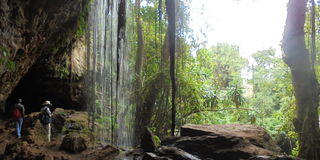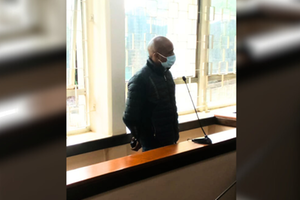Exploring the cave and grounds of Paradise Lost

Mbai Cave facing waterfall at Paradise Lost. Photo | Rupi Mangat
What you need to know:
The caves have history in Kenya’s colonial past.
-The Mau Mau took refuge in the Mbai Caves when the land was still forested.
- Mrs. Mukami Kimathi, the widow of the great Mau Mau freedom fighter Dedan Kimathi, opened the cave officially in 2015.
After a two-year hiatus, the birders from Nature Kenya are out again. Driving into Paradise Lost set in the midst of a coffee plantation and grass pastures boasting gigantic trees in flower, the morning sun is soft, warming the red earth of Kiambu.
A flock of white-shouldered widow birds flit on the grass plains, the tails of the males like ribbons in flight, a sign that they are in their breeding plumage, ready to mate.
Strolling along the coffee bushes, the rain-fed pool is dry with the sedges along the rim. They reveal a stunning Red-naped Widow bird – again the male showing off his bright colours as an advertisement that he’s also ready to mate.
The sky turns bluer with the rising sun hotter. A short distance away, a beautiful landscaped pond boasts a floating deck with a papyrus-fringed shoreline and the coffee bushes stretching into an endless sky.

The cascading waterfall l at Paradise Lost. Photo | Rupi Mangat.
A long-crested eagle lands on a towering palm, regal and stately. It is in no hurry to hunt but instead shows off its crest, fanning it open like a crown on the head. But the yellow-billed kites are not amused with the eagle and mob it, to chase it away. But the eagle stays solid on its perch – a clear profile of the raptor that is the logo of Nature Kenya, also known as The East African Natural History Society, established in 1909. The organisation pioneered conservation matters in East Africa.
With binoculars turned skywards, a pair of great wings in the sky turns out to be a pair of grey crowned crane, today listed as ‘critically endangered’. A census in recent years reveals we have some 7500 in the country. Our pair land a few feet away from us by the water’s edge, tall and elegant. The male fluffs his feathers showing off his plumage. The cranes are photographed with the jacanas (also called the Jesus bird because they appear to be walking on water while instead they are walking on the floating water lily leaves). A flock of yellow-billed ducks swim out from the papyrus while the sky stuns again with a purple heron and a booted eagle.
It’s close to midday now and we turn our attention to visit the waterfall and caves beyond the ponds and the gardens – but not before a trio of the paradise flycatchers has us enchanted with their beautiful coppery feathers and long tails.
There’s just so much going on with the bird list nearly at 80 species in three hours. “February is a great time for birding because all the migrants are here,” says Fleur Ng’weno who started the bird walks from the Nairobi Museum in 1972. She’s a legend in the birding world.
Being a week day, it’s quiet at Paradise Lost. The horses graze quietly on the lawns while the boat man enjoys ‘me’ time rowing in the pond.
We’ve reached the riverine forest and follow the Gichi River flowing past the ancient mugomo trees. A Montane Wagtail flits on the river stones, every few minutes enjoying a sip of water. Suddenly there’s excitement – a blue-headed sunbird is spotted in the scrub sipping nectar from the flowers.
The river path leads us down a slope and to the waterfall cascading over an enormous cave named Mbai. It’s dated at 2.5 million years old when our ancestors were still in the stone-age.
It’s time to enjoy the cool breeze and refreshing waterfall. Turning the torches on from the smartphones, we wander inside the pitch dark narrow tunnel to the end. It’s 164 feet of crouching where the roof is low to walking full height in most part. It boasts mini chambers like rooms. But when the torches are switched off, it’s a solid black world.
The caves have history in Kenya’s colonial past.
Mrs. Mukami Kimathi, the widow of the great Mau Mau freedom fighter Dedan Kimathi, opened the cave officially in 2015. Kimathi was hanged on 18 February 1957 fighting against colonial rule, aged only 36. The Mau Mau took refuge in the Mbai Caves when the land was still forested.
Past noon, we buy fresh grounded coffee from the factory and driving out, the first migrants of the day are perched on the wild shrubs – they are the Eurasian bee-eaters. Well-fed on insects in Kenya, they will soon fly back to Europe and Asia to breed – and hopefully do the 6,000-kilometre flight back to Kenya next year.
Fact File
You can camp, picnic, fish for black bass and tilapia, do a coffee tour or birding at Paradise Lost, 14 kilometres from Nairobi and a 30-minute drive from the city centre.
20 years ago the whole area was coffee and large tracts of grassland. Much is now housing estates.
Hence the wild space at Paradise Lost is an important part of a natural world that’s a refuge for people, birds and insects that keeps the earth healthy.
Join Nature Kenya for exciting adventures in nature.
www.rupitheafricantrotter.com




